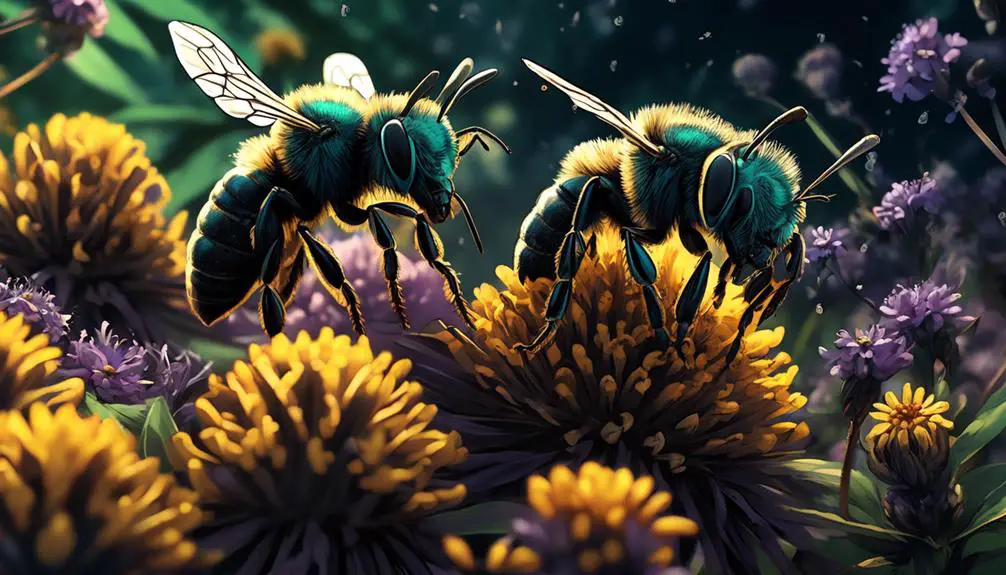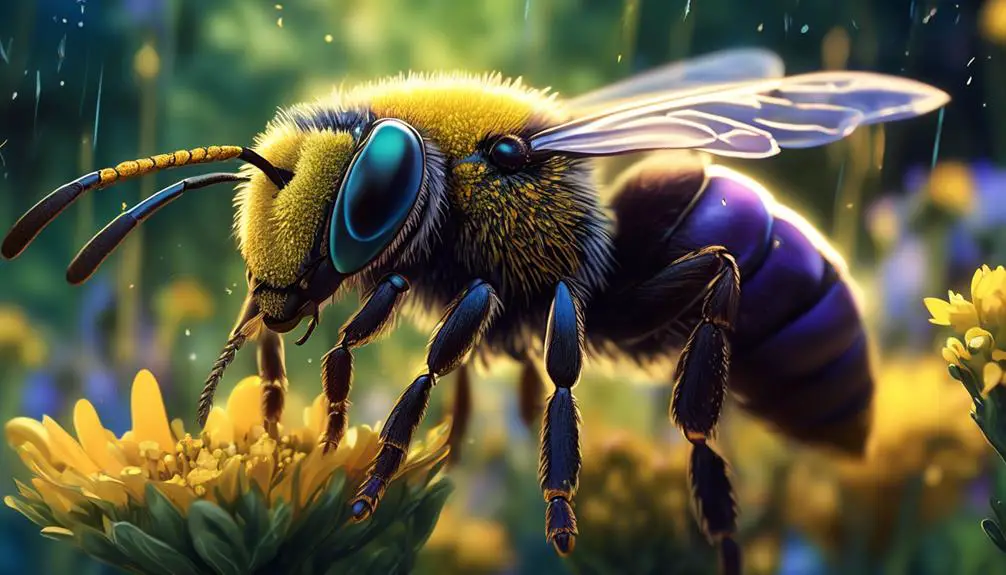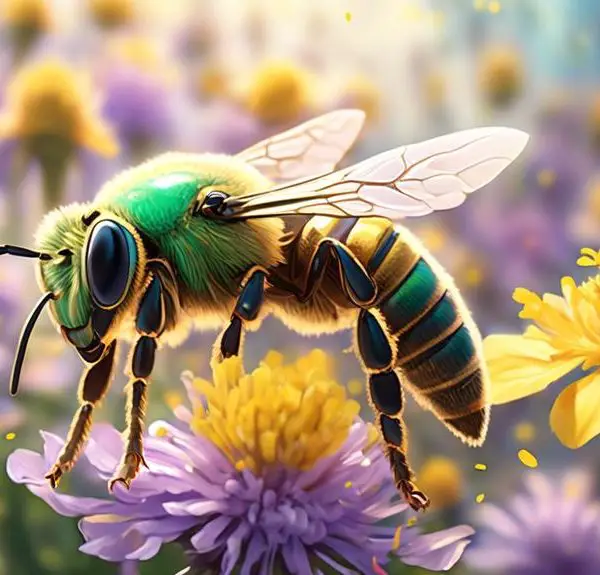Amid Michigan's frosty winters, discover the unexpected allure and ecological importance of the dark sweat bee.

Dark Sweat Bees Michigan
In the cold winters of Michigan, you'd hardly expect to find a creature as exotic as the dark sweat bee. Yet, this bee thrives here, painting a striking contrast between the snow-covered landscapes and its unique, metallic-hued body.
This tiny insect, often overlooked due to its size, holds a significant place in Michigan's ecosystem, displaying behaviors that might surprise you. Imagine, these bees are attracted to human sweat, hence their name, but there's more to their story.
As we explore their existence, habitat, and ecological importance, you'll soon realize why understanding Michigan's dark sweat bees is critical.
Key Takeaways
- Dark Sweat Bees are native to Michigan and are characterized by their dark metallic bodies.
- They are small in size and are attracted to human perspiration due to its salty content.
- Dark Sweat Bees play a vital role in Michigan's ecosystem as pollinators, enhancing biodiversity and supporting food production.
- Studying and protecting Dark Sweat Bees is crucial for conservation efforts and promoting a healthier and more sustainable ecosystem in Michigan.
Understanding Dark Sweat Bees

To truly grasp the nature of Dark Sweat Bees, you'll need to dive into their fascinating biology, unique behaviors, and the vital role they play in Michigan's ecosystem.
These bees, scientifically known as Lasioglossum species, are native to Michigan and are recognized by their dark metallic bodies. They're small, typically ranging from 0.2 to 0.4 inches.
You may wonder why they're called 'sweat' bees. Well, they're attracted to human perspiration due to its salty content, but don't worry, their sting is quite mild. Intriguingly, they exhibit a trait called kleptoparasitism, where some females steal resources from others.
Now, let's delve into their role in the ecosystem. Dark Sweat Bees are pivotal pollinators, often visiting a diverse range of flowers. Without them, the reproduction of many plant species would be jeopardized, affecting the entire food chain.
Understanding these bees isn't just for academic interest. It's integral to preserving Michigan's biodiversity. So the next time you spot a Dark Sweat Bee, remember, they're not just a nuisance, but a crucial part of our ecosystem.
Dark Sweat Bees' Habitat in Michigan

Having grasped the significance of Dark Sweat Bees in Michigan's biodiversity, let's now explore their specific habitats within the state.
Dark Sweat Bees are incredibly adaptable, thriving in diverse environments. However, they're most commonly found in areas with abundant flowering plants, where they can easily access nectar and pollen.
In Michigan, you'll likely spot these bees in habitats such as gardens, meadows, and forests. Specifically, they're prevalent in deciduous woodlands, where the abundance of flowering plants and the presence of dead trees for nesting purposes cater to their needs perfectly.
Despite their adaptability, Dark Sweat Bees require a certain amount of sunlight. Therefore, they're rarely found in densely shaded areas. Instead, they seek out sunny spots where flowers are abundant throughout the warm months.
One interesting aspect about their habitat selection is their preference for solitary nesting. Most often, they'll excavate their nests in bare or partially vegetated ground, steering clear of heavily grassy areas.
Unique Behavior of Dark Sweat Bees

Now, let's delve into the unique behavior of Dark Sweat Bees, a fascinating aspect that further distinguishes them within the bee world.
Unlike their colorful cousins, these bees aren't just nectar gatherers. They're also known as Lasioglossum, the largest genus in the bee family, and are widely recognized for their sweat-drinking habit. This is where they get their common name from.
You might wonder why they do this. Scientifically, it's quite simple. Dark Sweat Bees are attracted to salt. And where better to find salt than in human sweat? This behavior isn't just unique, it's also significant. It shows a remarkable adaptability to varied sources of nutrition.
Late in summer, you'll notice another interesting behavior. The female bees, after mating, will seek out soft soil or sand, and begin digging a burrow. This isn't just any burrow, but a complex network of chambers and tunnels where they'll lay their eggs. Each chamber is provisioned with a mixture of nectar and pollen, a perfect meal for the emerging larvae.
This meticulous nest-building behavior sets Dark Sweat Bees apart from many other bee species.
Ecological Importance of Dark Sweat Bees

While the unique behaviors of Dark Sweat Bees are indeed captivating, it's their ecological role that truly underscores their importance in our environment. As you may know, bees in general are crucial for pollinating plants, which in turn supports biodiversity, food production, and overall ecosystem health. But Dark Sweat Bees, specifically, hold a special place in this ecological balance.
Pollinators | Impact on Ecosystem | Dark Sweat Bees Role |
|---|---|---|
Bees | Enhance biodiversity | Pollinate specific plants others may not |
Dark Sweat Bees | Support food production | Pollinate fruits, nuts, and vegetables |
Bees | Maintain ecosystem health | Help plants reproduce, attracting wildlife |
When you take into account that they pollinate a variety of plants, including fruits, nuts, and vegetables, it's clear that they play a major role in supporting our food production. Moreover, they often pollinate plants that other bee species may not, enhancing biodiversity. By helping plants reproduce, these bees also attract other wildlife, thus maintaining overall ecosystem health.
Studying and Protecting Michigan's Dark Sweat Bees

In order to better understand and safeguard these important pollinators, it's crucial that we delve into the study and protection efforts surrounding Michigan's Dark Sweat Bees. Scientists are focusing on identifying different species, understanding their behaviors and habitats, and assessing their current status and potential threats.
Firstly, you're involved in the process of species identification. Using morphological features and genetic analysis, you're distinguishing between similar-looking species. This is vital, as it allows for accurate monitoring and conservation efforts.
Secondly, you're studying their ecology. By observing their foraging patterns, nesting habits, and interaction with plants, you're gaining insights into their specific ecological roles. This informs habitat management strategies and helps in predicting how changes in environment might impact them.
Lastly, you're assessing potential threats. Pesticide exposure, habitat loss, and climate change are often the main culprits impacting bees. You're investigating these factors and their effects on Dark Sweat Bees, which can guide policy decisions.
To protect these bees, you're developing and implementing conservation strategies. This includes creating pollinator-friendly habitats, reducing pesticide use, and promoting public awareness.
Through your diligent work, you're not only protecting these vital pollinators, but also contributing to a healthier and more sustainable ecosystem in Michigan.
Conclusion
You've now explored the world of Michigan's dark sweat bees. Nestled in their unique habitats, these bees exhibit fascinating behaviors, contributing significantly to our ecosystem.
Their study and protection remain vital to maintain Michigan's biodiversity. Embrace these small wonders – they're not just bugs, they're an integral part of our environment, pollinating plants, and ensuring the survival of our ecosystems.
Remember, every creature, no matter how small, plays a role in the grand scheme of nature.


